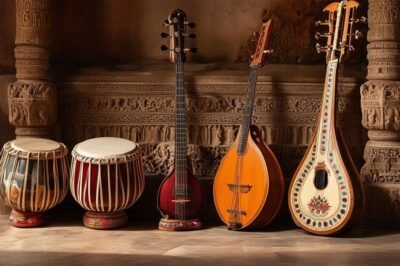Indian classical music is a deeply rooted tradition that has evolved over centuries, shaping not only India’s musical landscape but also influencing global genres. Its origins lie in ancient texts, and it has been passed down through generations, preserving the integrity of its form while gradually adapting to contemporary influences. Today, Indian classical music continues to thrive, blending with modern Indian music and global sounds, resulting in unique forms of classical music fusion that resonate with audiences worldwide.
The Foundations of Indian Classical Music
At the heart of Indian classical music are two major systems: Hindustani from the north and Carnatic from the south. Both traditions emphasize the importance of raga (melodic frameworks) and tala (rhythmic cycles) as the foundation for musical expression. These systems were developed over thousands of years and are closely tied to the country’s cultural music traditions, reflecting spiritual, philosophical, and emotional themes.
Central to these traditions are traditional music instruments such as the sitar, tabla, veena, mridangam, and flute. These instruments are integral to the unique sound and structure of Indian classical music, creating intricate melodies and rhythms that have enchanted audiences for centuries. Each performance is a conversation between the musician and the audience, rooted in improvisation, deep knowledge, and spiritual expression.
Preserving Tradition Amid Modernity
Despite the rapid modernization of music globally, Indian classical music has managed to retain its traditional essence. Renowned maestros such as Ravi Shankar, Zakir Hussain, and L. Subramaniam have not only preserved these age-old traditions but have also popularized them across the world. Through their masterful performances on traditional music instruments, these artists have brought classical Indian sounds to global platforms, influencing Western musicians and audiences alike.
While the integrity of classical forms is still maintained, younger generations of musicians are exploring ways to make this ancient art form more accessible to contemporary audiences. This has given rise to classical music fusion, a creative blend of classical Indian elements with modern genres such as jazz, rock, and electronic music.
Classical Music Fusion: Bridging the Gap
The rise of classical music fusion marks a new chapter in the evolution of Indian classical music. Many modern Indian musicians are blending traditional melodies and rhythms with modern instruments and global music styles. Artists like Shankar Mahadevan, A.R. Rahman, and fusion bands such as Indian Ocean have brought classical Indian elements into the mainstream, creating a new genre of modern Indian music that appeals to younger audiences while retaining the soul of classical music.
This fusion has not only attracted global listeners but has also made classical music more accessible to the Indian youth, who may find it easier to connect with familiar genres like rock or electronic music. These collaborations bring together the old and the new, ensuring that the cultural music traditions of India continue to evolve while remaining relevant in the modern world.
The Future of Indian Classical Music
As Indian classical music continues to evolve, it is clear that both tradition and innovation will play vital roles in its future. The preservation of traditional music instruments and classical forms will remain important, as they serve as the foundation for newer interpretations. At the same time, the fusion of classical elements with contemporary styles is helping to push boundaries, creating fresh, innovative sounds that are resonating with global audiences.
Conclusion: Tradition Meets Modernity
The evolution of Indian classical music reflects a dynamic balance between tradition and modernity. As it continues to influence and integrate with modern Indian music, the genre remains a vital part of India’s cultural music traditions. Through classical music fusion, the rich legacy of Indian classical music is being preserved while also embracing new forms and reaching wider audiences, ensuring its place in both India’s cultural heritage and the global music scene.








Leave a Reply